What Is Sponsored Content?
Sponsored content is a type of paid advertising where the sponsor pays a partner (like an influencer or website) to publish a promotional content piece on their behalf.
Sometimes, sponsors create content and send it to partners to publish. But they often pay their partners to produce it for them. So the tone and style can match the partner’s typical content and appear more natural to their audiences.
And sponsored content can appear in many different formats. Like infographics, blog posts, videos, and social media posts.
Typical goals of sponsored content can include:
- Increasing brand awareness
- Promoting a new product or service
- Boosting sales
What Does Sponsored Content Look Like?
Sponsored content can look a lot like organic (unpaid) content. But you’ll often see a label or hashtag on a sponsored post.
Those might say:
- “Sponsored by”
- “In collaboration with”
- “Paid partnership”
- “Ad”
- “This post was published in partnership with”
Here’s an example of a sponsored TikTok video that the author marked with the hashtags #ad and #paidpartnership.
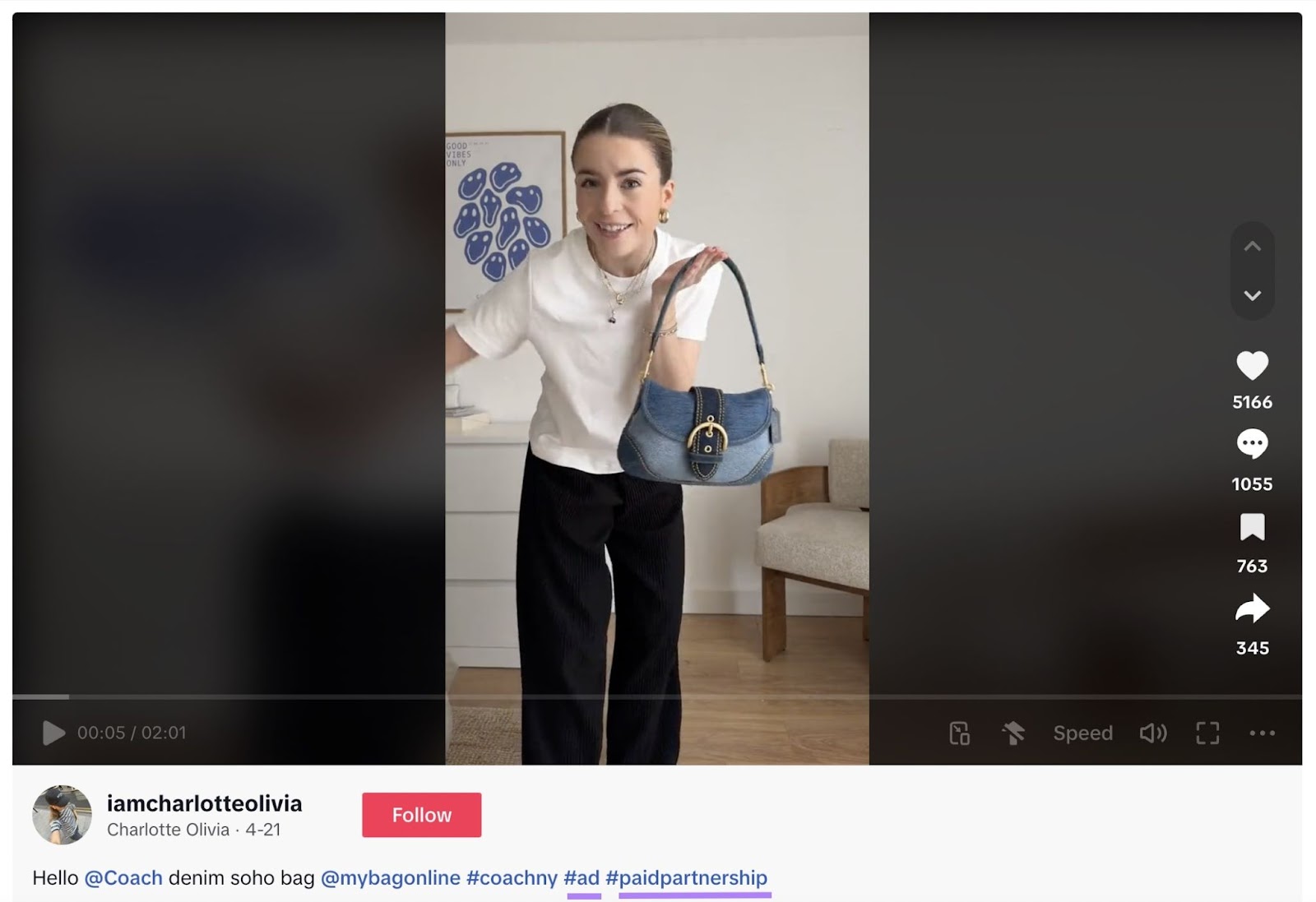
Some countries (like the United States) require sponsored content to be marked with these types of notes.
But even if your country doesn’t have this requirement, you should still consider marking your content (or encourage your partners to do so). To promote transparency and build trust with your target audience.
Why Should You Use Sponsored Content?
Including sponsored content as a part of your marketing efforts can help you reach goals like:
- Targeting a new and/or specific audience: When you partner with the right creator that speaks to the audience you want to target, you can build a relationship with that audience faster. Because the audience likely already trusts your partner.
- Increasing referral traffic to your website: Sponsored content often includes links to your site. Which can increase your referral traffic, and hopefully help you achieve your other business goals. Like more leads or sales.
- Establishing yourself as a thought leader: By getting featured in industry-leading publications or mentioned by key creators in your niche, you can build social proof that shows your business is credible.
Sponsored Content vs. Native Advertising vs. Advertorials
Native advertising and advertorials are specific types of sponsored content.
Native advertising matches the content of the webpage it’s displayed on. So it’s often hard to distinguish what’s organic and what’s paid content.
Examples include:
- In-feed social media ads
- Sponsored search results
- Recommended content at the end of articles
- Email newsletter ads
Here’s an example of a native ad on LinkedIn, which looks quite like a standard post:
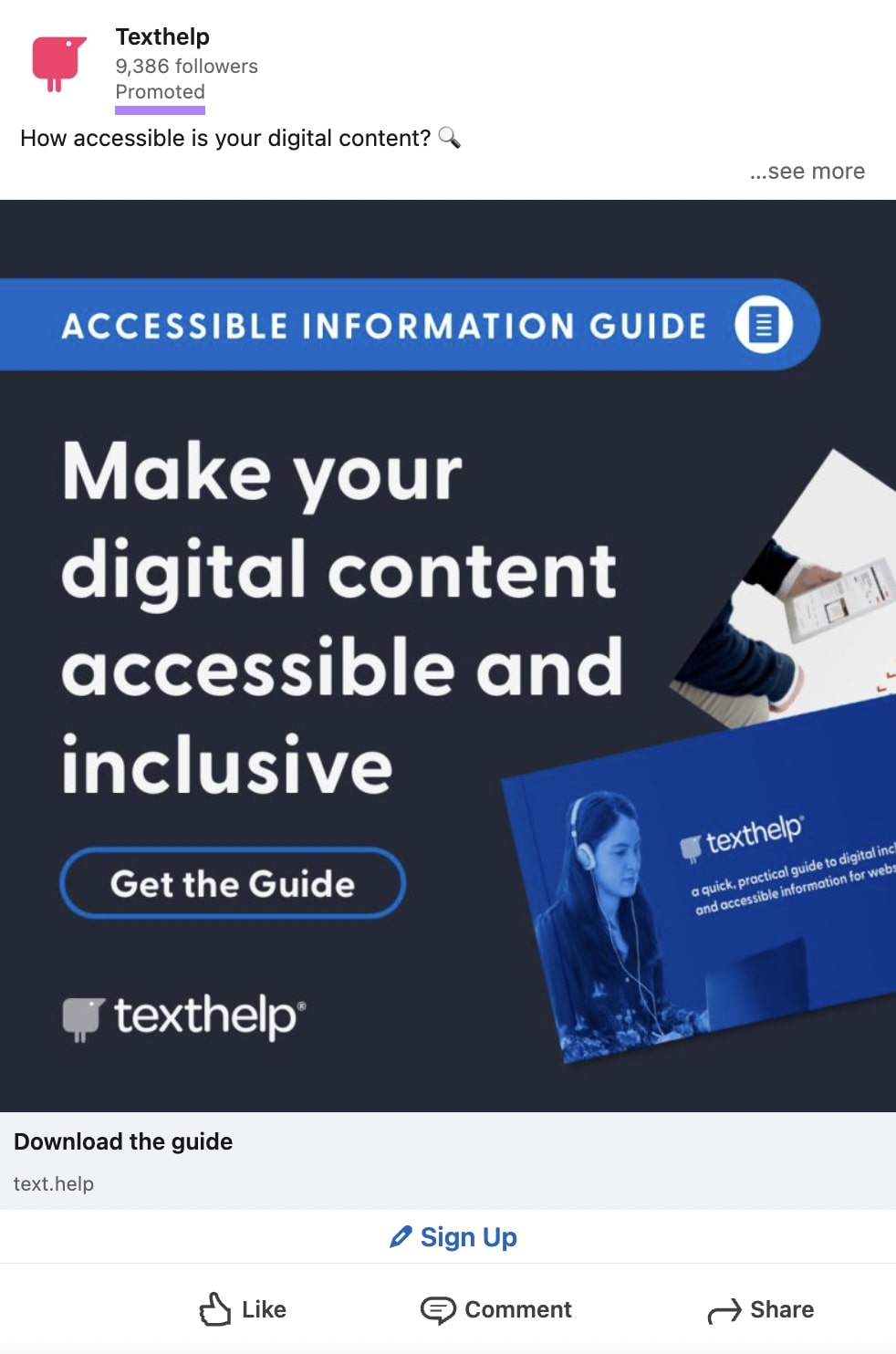
Advertorials are created by the publisher and designed to look like the rest of their articles. And you can use them to reach audiences on reputable, industry-relevant platforms.
Here’s an example of an advertorial for a boating show published on a boating website:
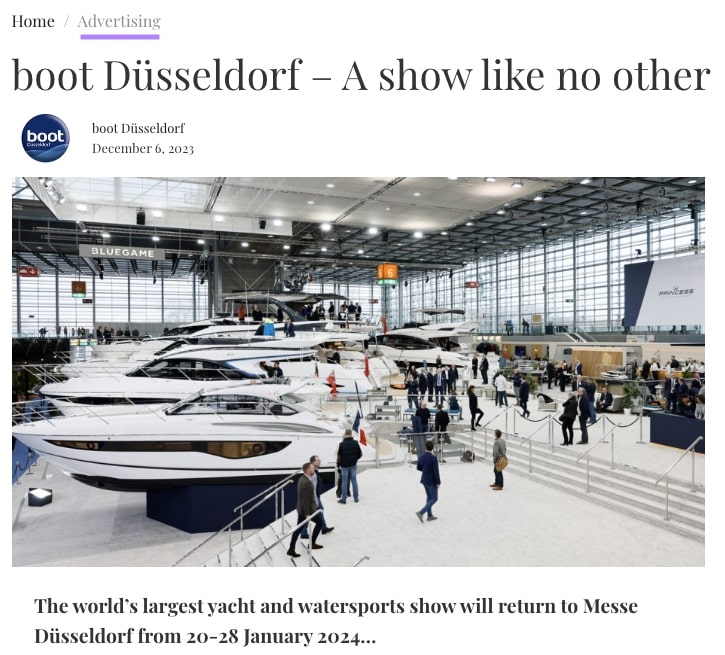
6 Sponsored Content Examples
Let’s explore some sponsored content examples created in different formats and published on various online platforms.
Telegraph UK and Visit Dubai
Telegraph U.K.’s Travel section allows advertisers to sponsor entire content pillars on the site.
In this example, they’re partnering with Dubai’s official tourism board to publish a variety of destination-related content.
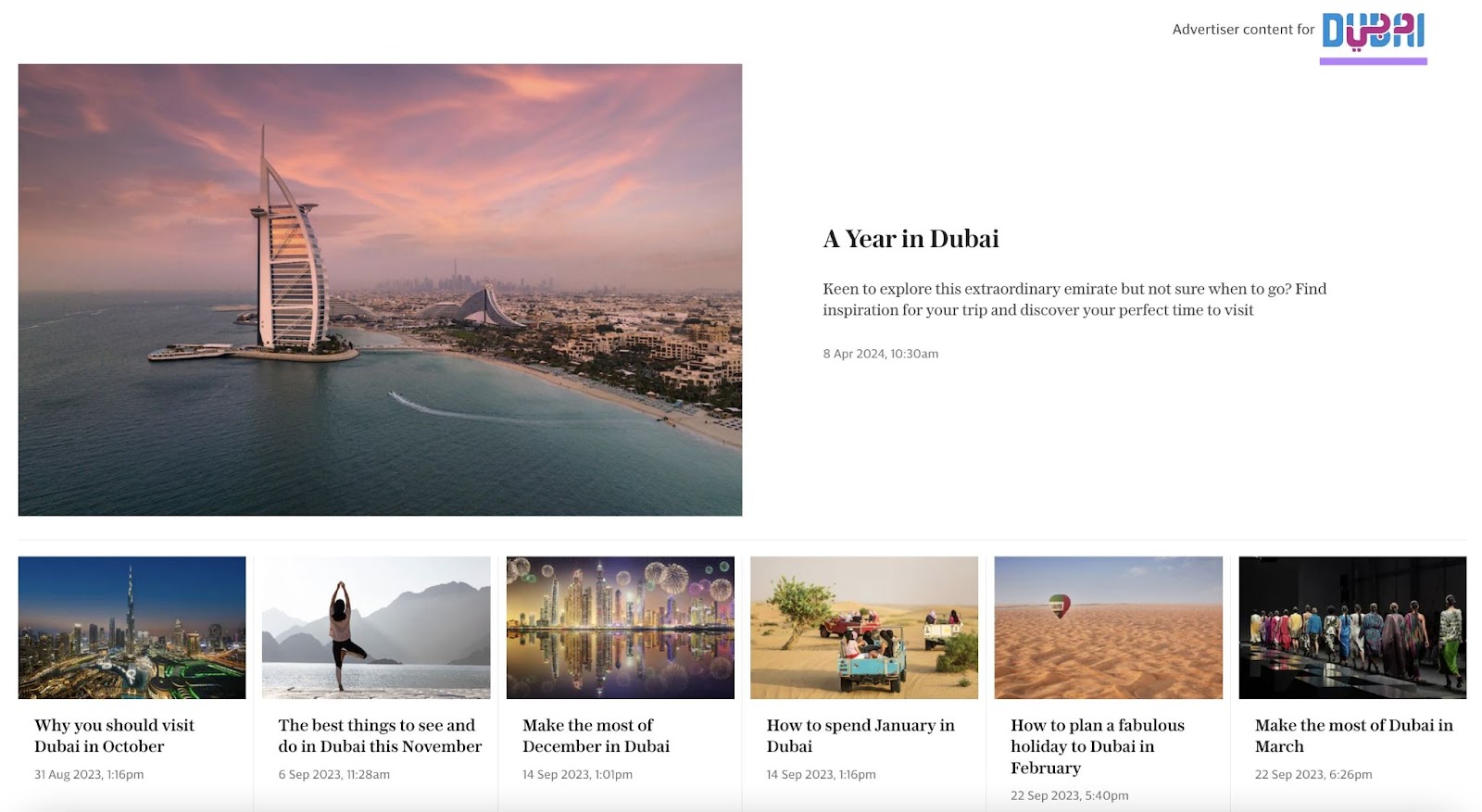
Why This Partnership Works
- Sponsor: Telegraph U.K. is an authoritative website with a high number of monthly visitors. Which helps drive awareness of Dubai as a travel destination.
- Creator: Having a sponsor for a specific travel-related section of the site allows Telegraph U.K. to double down on a specific destination and cover it in great detail. And earn money to keep their content production running.
If you want to check whether a website is a good candidate for sponsored content, use Semrush’s Domain Overview.
Enter your target partner’s domain and click “Search.”

You’ll then see some information about the website’s authority and how much traffic it gets from search every month.

A website that gets a lot of monthly organic traffic could be a worthwhile partner.
And note that it may be worth checking the specific section of the website where your sponsored content may appear. To get a better idea of your true potential results from the partnership.
Ali Abdaal and Brilliant
Ali Abdaal is a YouTuber who creates videos about productivity, habit-building, and learning new skills. He partners with sponsors whose products he uses personally and that match the topics his subscribers are interested in.
For example, Abdaal posted a video reviewing a productivity book that was sponsored by Brilliant (a company that creates interactive lessons to improve STEM knowledge).
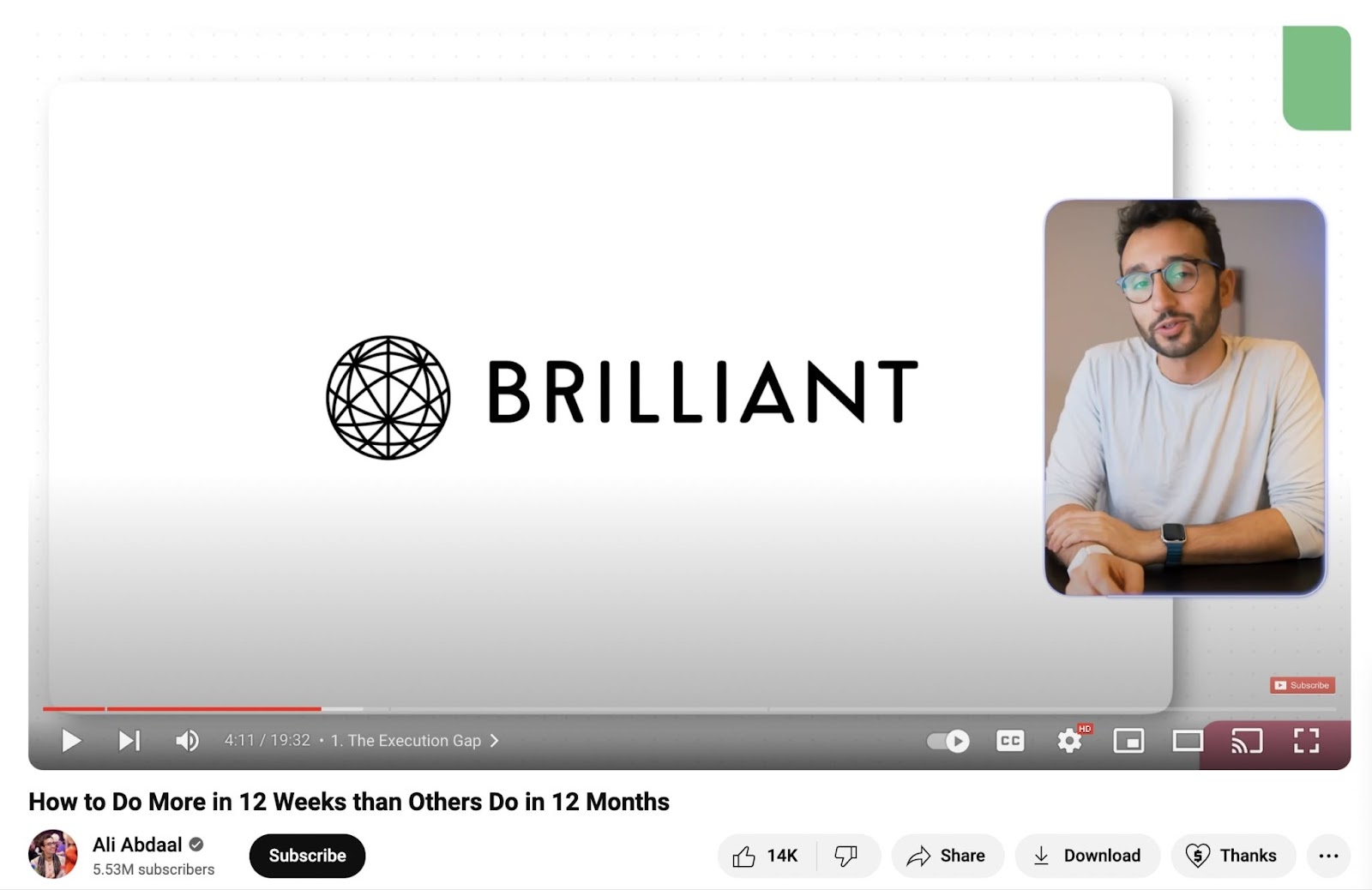
Why This Partnership Works
- Sponsor: Abdaal’s audience includes people who are interested in learning new skills and building learning habits, which they can do with Brilliant’s products
- Creator: Partnering with brands aligned with his channel lets Abdaal maintain trust with his audience while monetizing his channel
Carolina Kowanz and Preply
Carolina Kowanz is a creator who shares helpful tips for learning the English language. And many of her partners are companies in the language learning space.
This example shows a partnership between her and Preply, a language-learning marketplace:
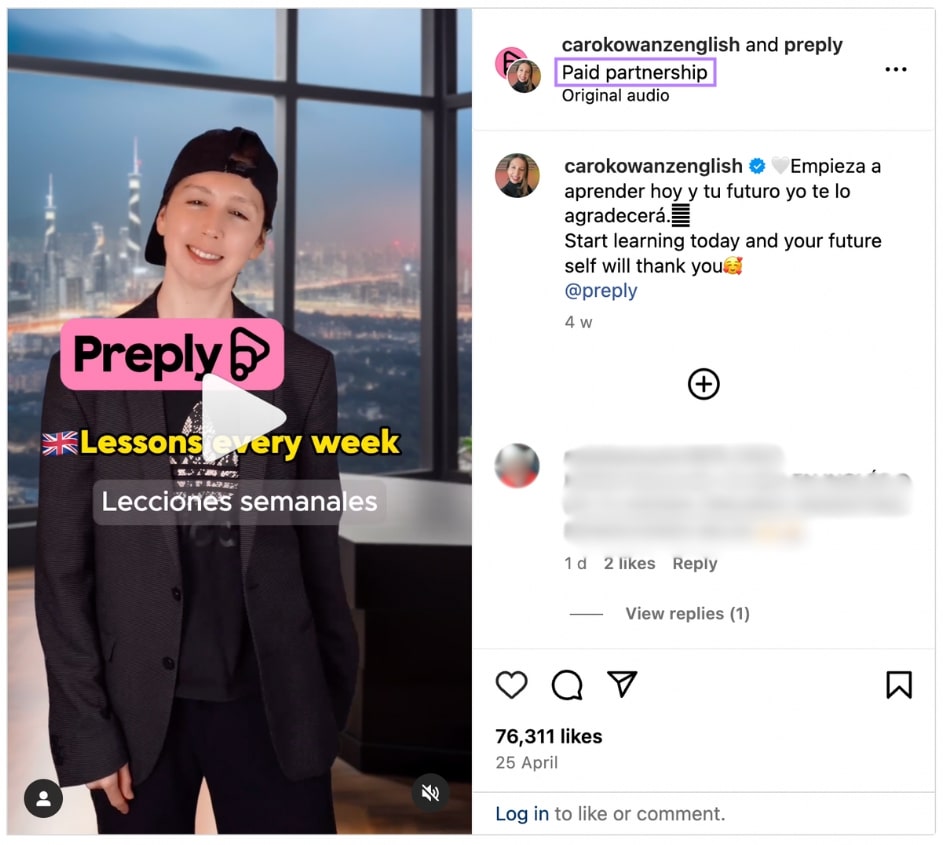
Why This Partnership Works
- Sponsor: Partnering with Kowanz allows Preply to expand its reach and attract new customers
- Creator: Partnering with a language-learning brand lets Kowanz get paid for the content she usually publishes. And present a product her audience is likely to be interested in.
Minuttia and Superpath
Superpath is a content marketing community. And Minuttia is a content marketing agency that sponsors various content formats through Superpath to reach its target audience.
Superpath regularly hosts webinars in which the Minuttia’s CEO shares information on topics within the content marketing industry—from fixing broken client relationships to creating content briefs.
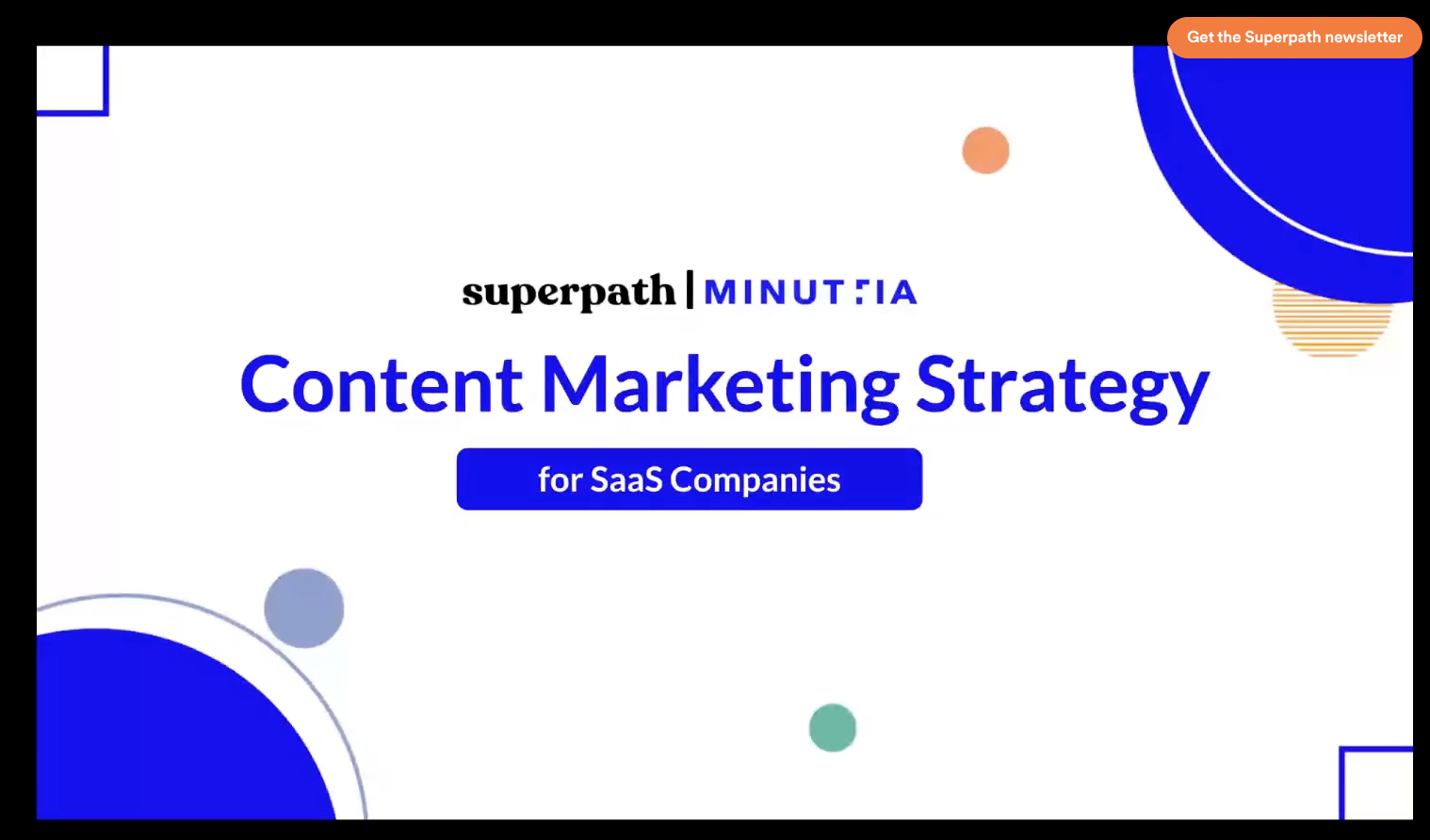
Why This Partnership Works
- Sponsor: Superpath’s sponsored content includes educational material that solves the problems of Minuttia’s ideal customers. Which can help the agency position itself as an authority in the industry.
- Creator: The collaboration helps Superpath engage their community with educational webinars
Zach King and Royal Caribbean
Zach King is a popular TikTok creator who publishes “magic” videos—he edits his videos in a way that creates an illusion.
He was one of the influencers invited to Royal Caribbean’s cruise on the Icon of the Seas, the largest cruise ship in the world.
While aboard, he and his family recorded videos that were later published and marked as ads for Royal Caribbean.
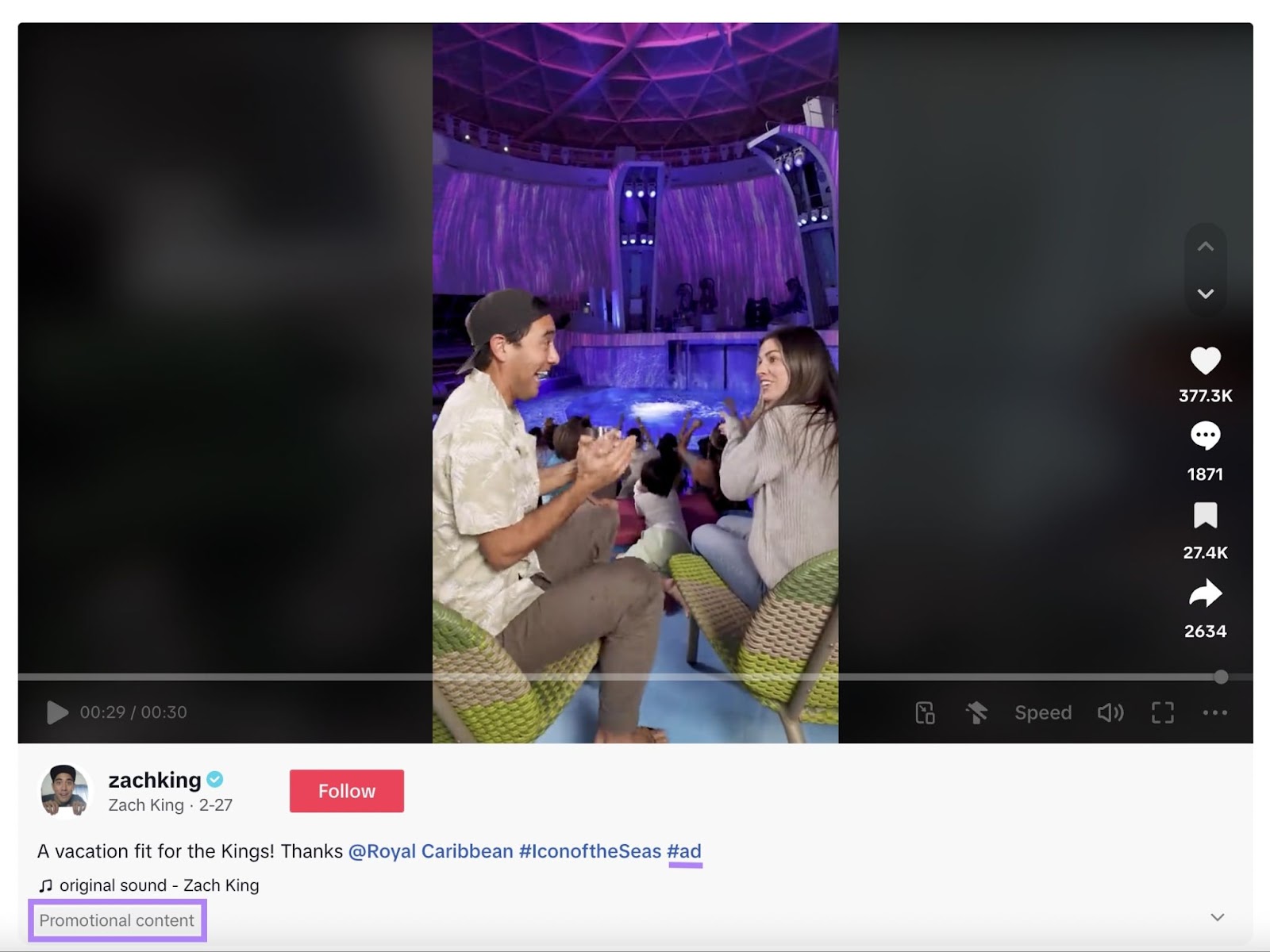
Why This Partnership Works
- Sponsor: Royal Caribbean can expand its reach quickly through King’s large audience. Plus, they can be perceived as an easy-going, entertaining cruise brand by being associated with a fun creator.
- Creator: A cruise is a unique place for creating the kind of fun videos King usually posts. He had the freedom to create posts with his family included—and get compensated.
Erin Balsa and Navattic
Erin Balsa is a content marketing expert. One of the content formats she regularly uses is a newsletter for fellow marketers called Leading Thoughts.
In this newsletter example, she partnered with Navattic, an interactive product demo software. The brand had its own separate section at the top of the newsletter:
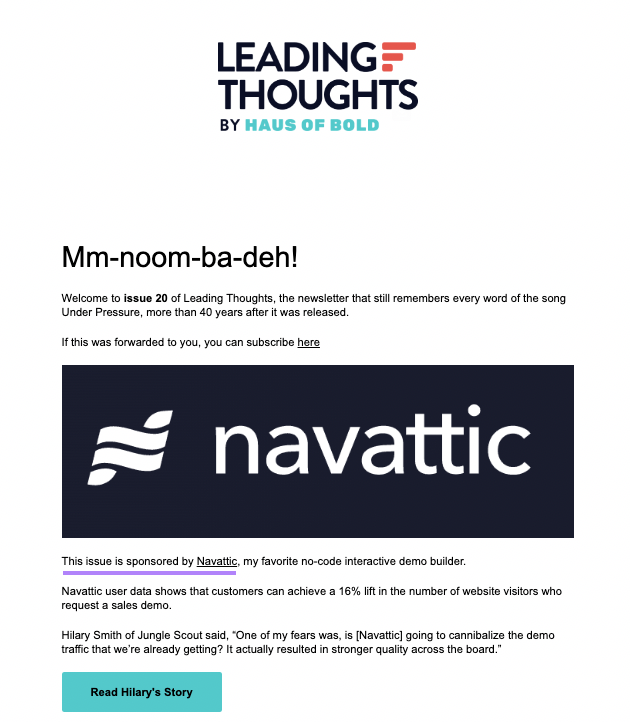
Why This Partnership Works
- Sponsor: Balsa’s audience largely consists of B2B marketers who are likely to be interested in using this software or recommending it to the sales team in their companies
- Creator: Balsa can introduce a product her audience may be interested in and resolve a problem they may be having. And monetize her newsletter.
How to Get Started with Sponsored Content in 5 Steps
Step 1: Research Your Audience
It’s important to know who you’re speaking to and where they hang out online. So you can choose the right platform for your sponsored content.
Use Semrush’s One2Target to learn more about your audience demographics and online behavior.
Enter up to five competitors and click “Analyze.” (Your competitors’ collective audience is likely similar to your target audience.)
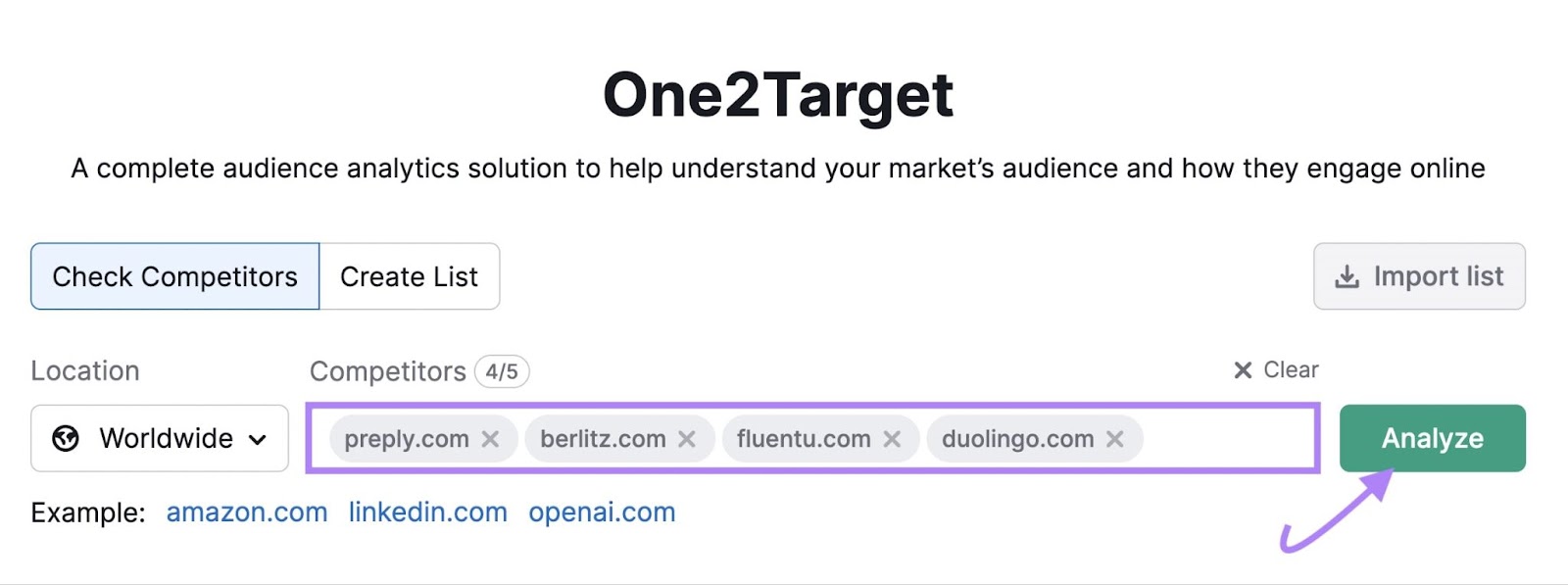
First, you’ll see key demographics like age, gender, and distribution by country.
To see which platforms your audience uses, click on the “Behavior” tab.
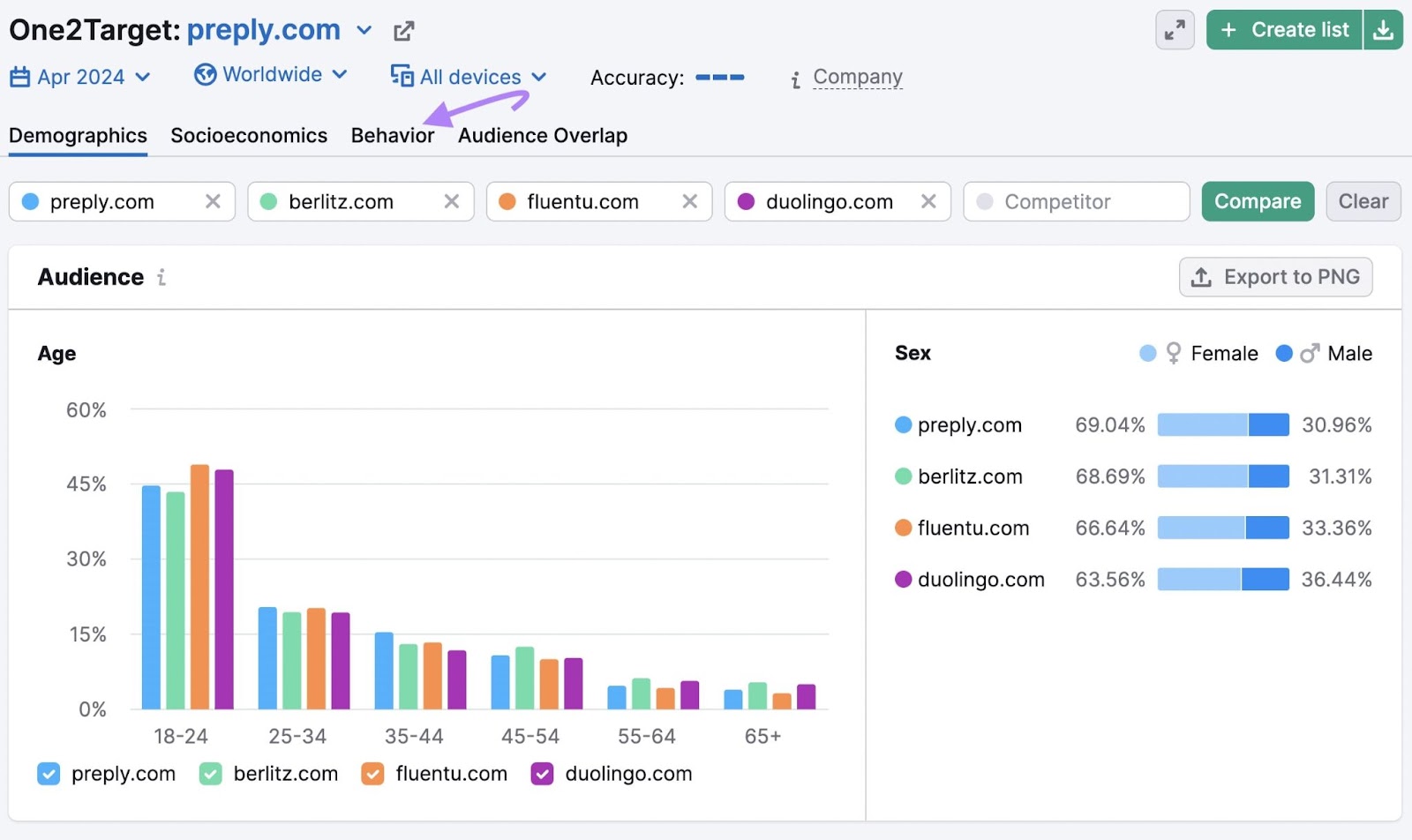
Look at the “Social Media” section. This gives you a breakdown of the platforms your target audience visits most often.
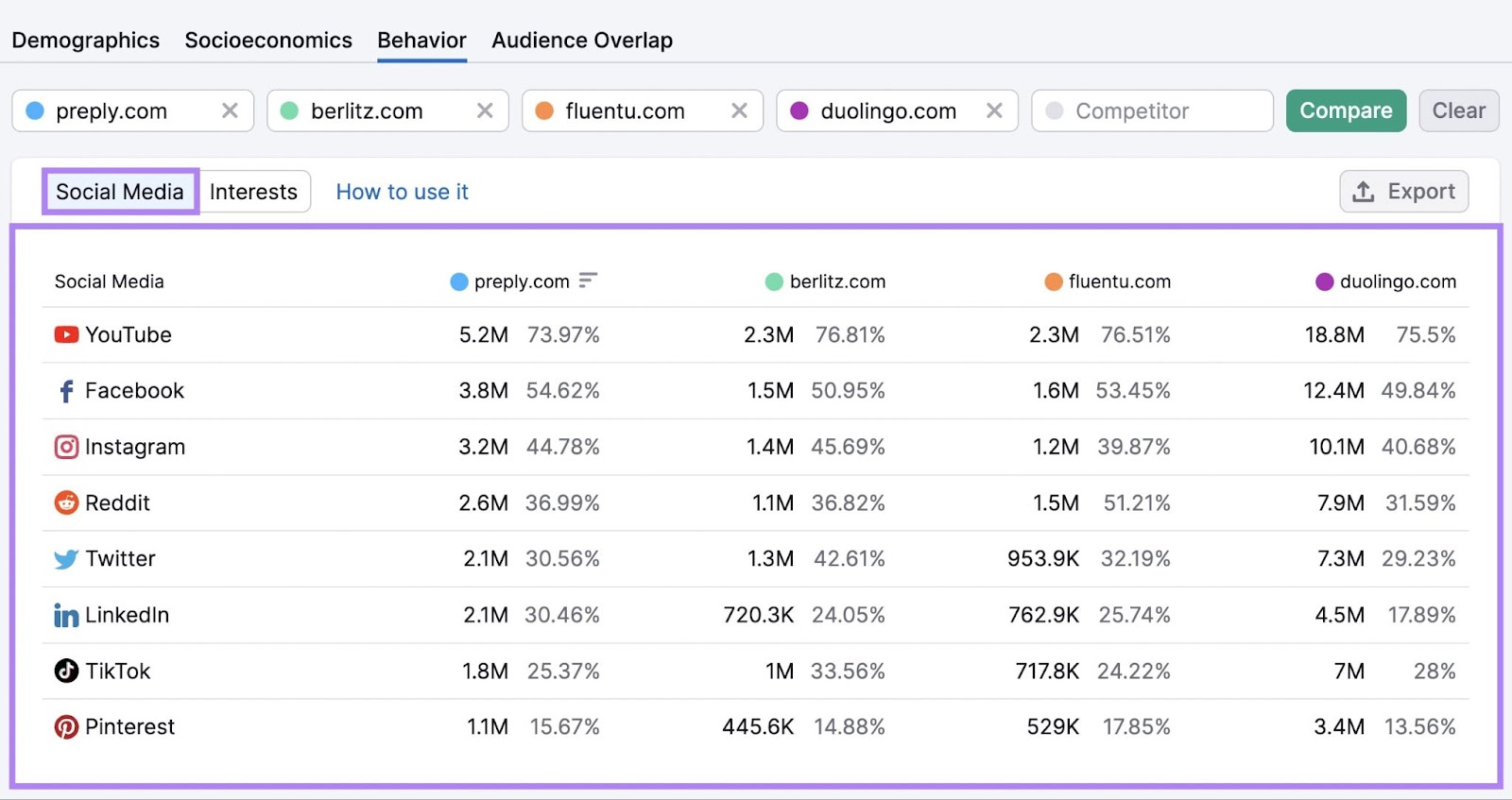
The platforms your target audience uses most are probably the best places to start looking for partners to work with.
Step 2: Find Relevant Creators
You need to find reliable and trustworthy partners in your niche who can convey the right message to your target audience. Otherwise, you’re unlikely to achieve your goals.
Here’s how to do it:
Go to Influencer Analytics.
Click “Influencer Discovery” and select one of the platforms your target audience uses most (we found these with the One2Target tool in the previous step).
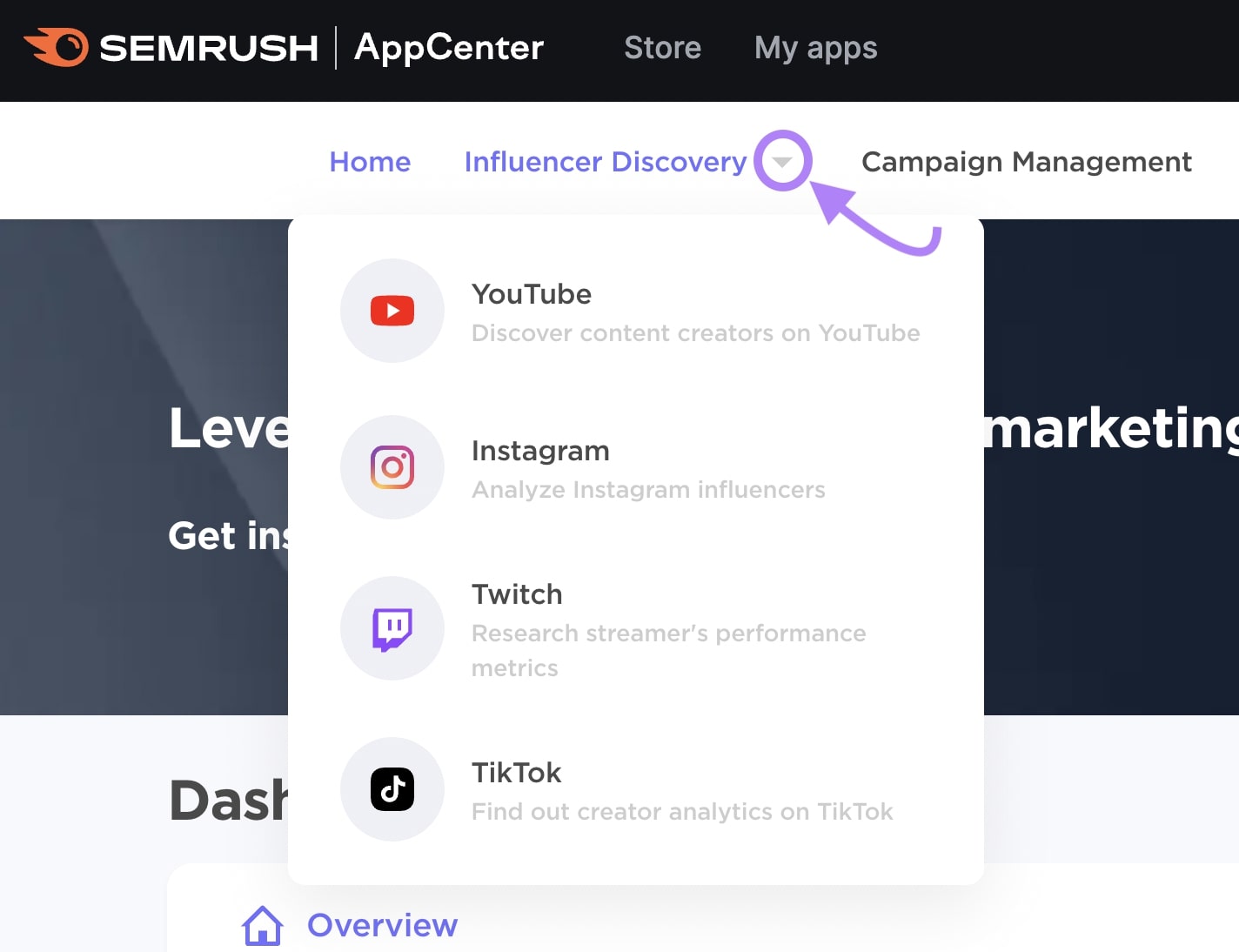
Click on the “Filters” button to start clarifying what kind of creator you’re looking for.
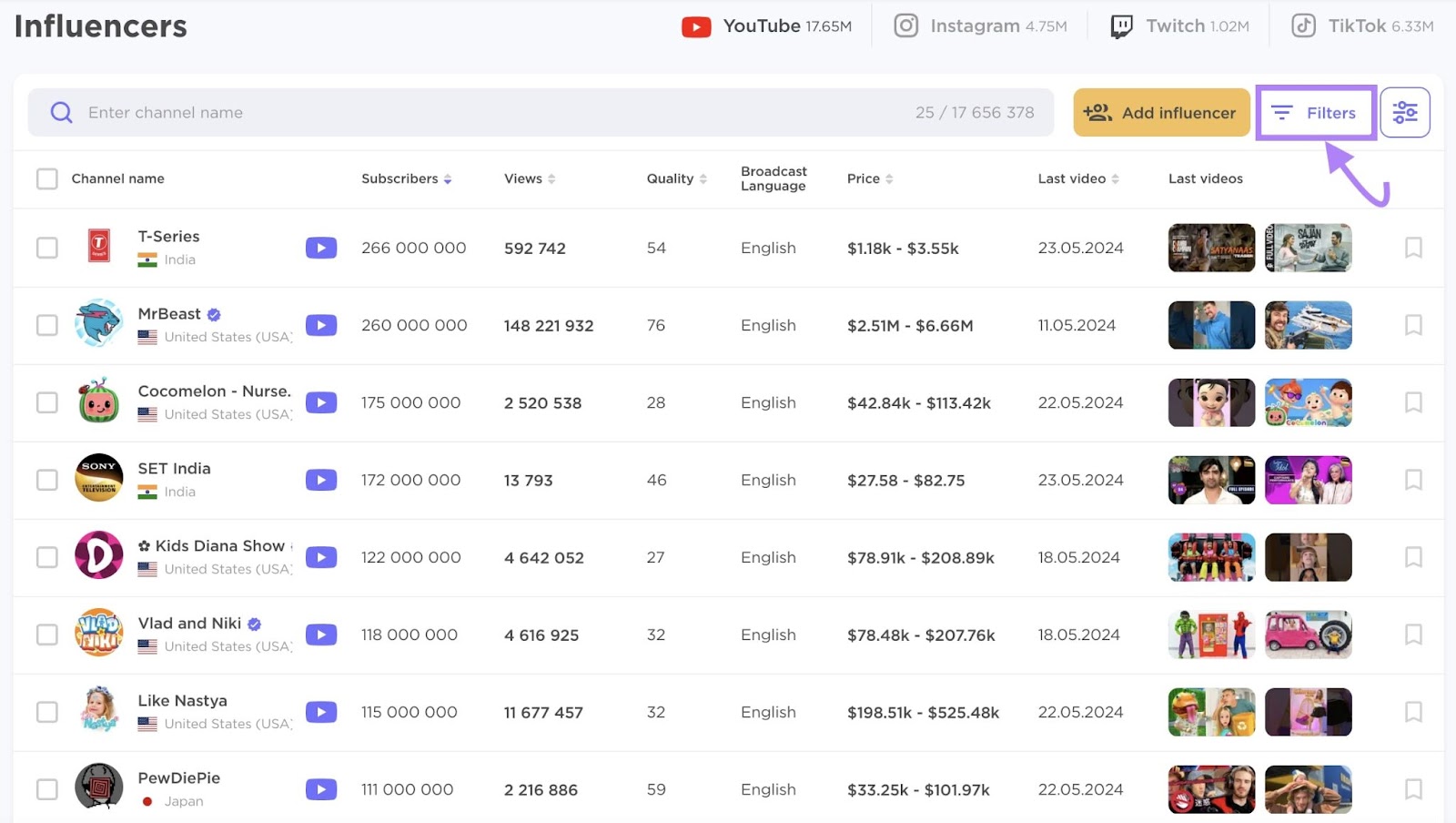
You can narrow your results based on things like account metrics, location, and price.
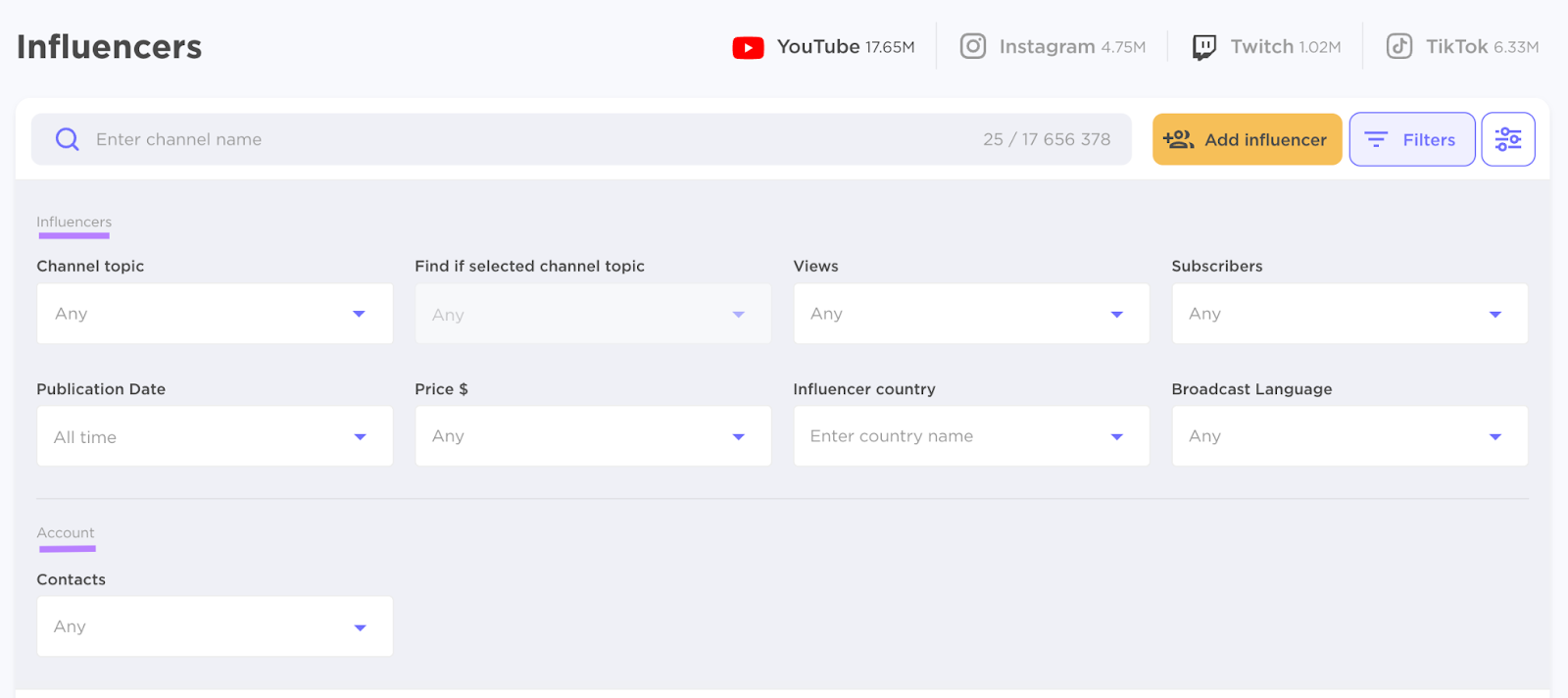
Once you add your filters, scroll down to see the list of creators you can potentially collaborate with.
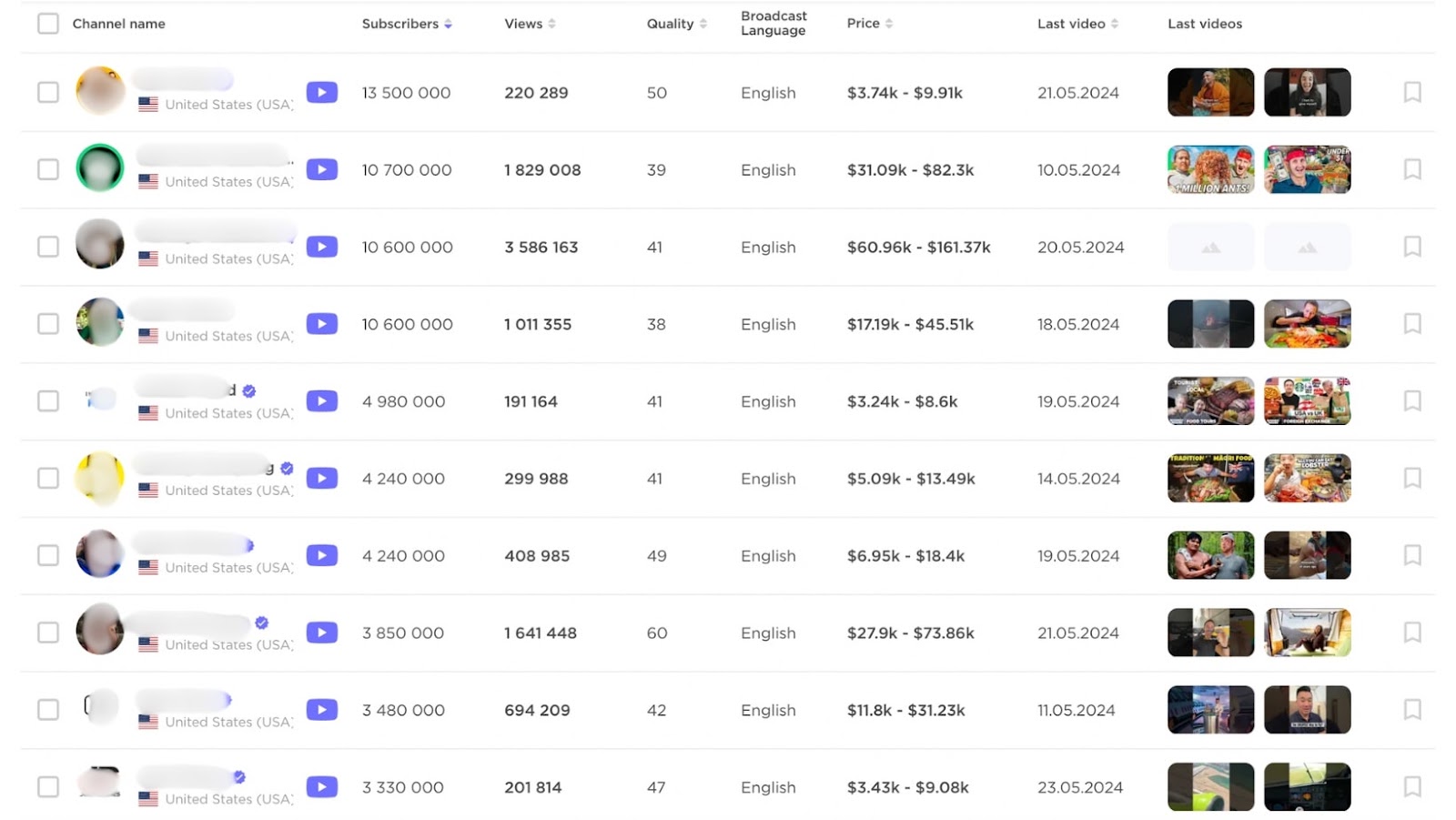
But your research doesn’t end here. Take this list, visit the accounts, and analyze each creator.
Here are some questions that can help you analyze the profiles and decide who to partner with:
- Is there a significant difference in how they communicate in their organic posts compared to sponsored posts?
- Is there a difference in engagement on organic vs. sponsored posts?
- Does their tone of voice match the kind of message you want to get across?
- Would you want your brand to be associated with this creator and the other brands they promote?
- Do they get engagement on their organic and sponsored posts?
Step 3: Align Your Expectations and Requirements
Aligning with your partner on expectations ensures both of you are on the same page. So you can reach your goals without disrupting their content.
For example, you may want to increase sales for your latest product by sharing a picture of it and a promo code. But that may not align with the type of content this creator publishes.
Instead, they may suggest creating a video of them using the product and reviewing it, which might be something their audience is already familiar with.
Like this example from Unbox Therapy:
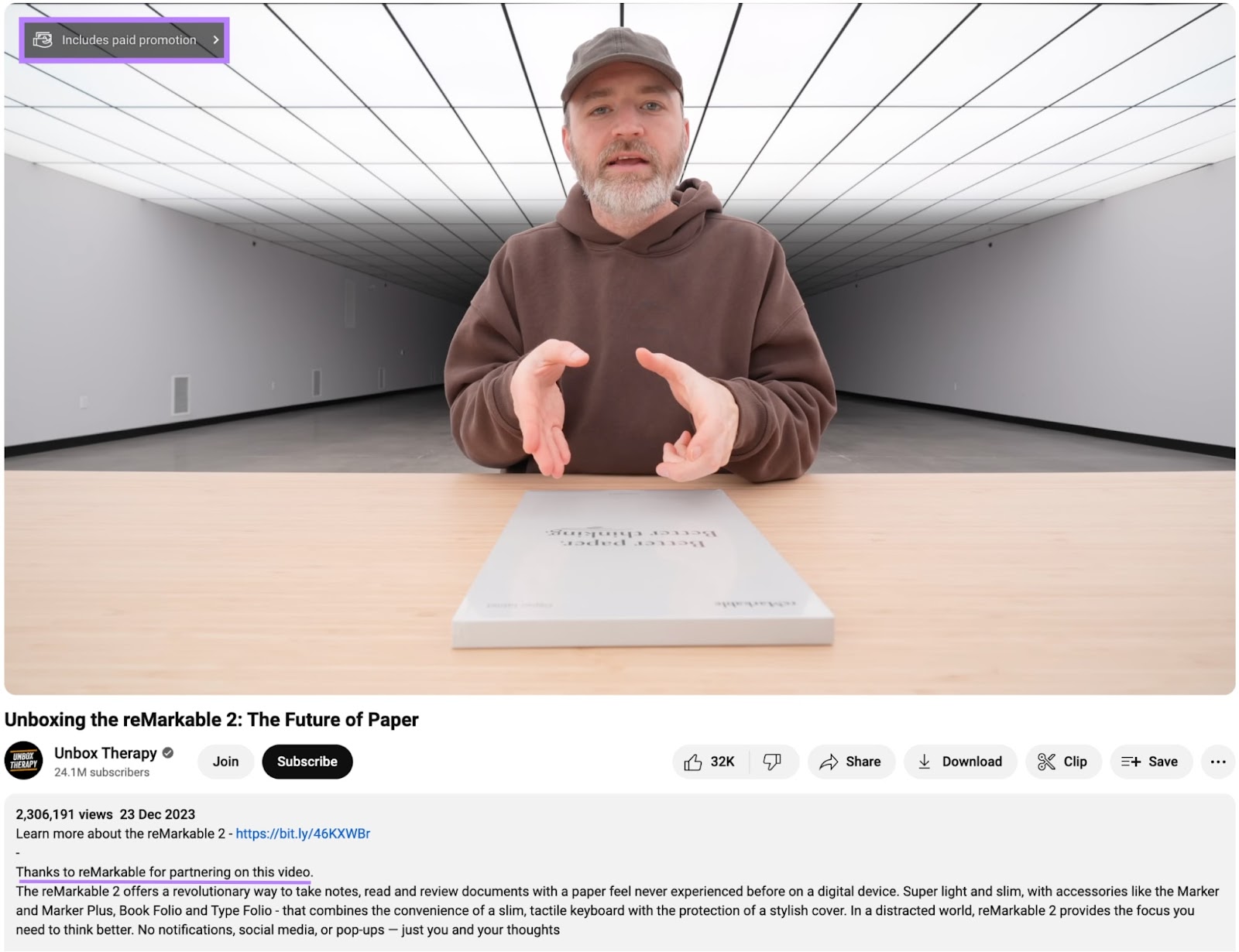
Here are some tips to set yourself up for a successful collaboration:
- Explore the partner’s popular content formats: To get an idea of how your brand could fit into their post
- Ask the partner about content creation: To understand how you could get involved and check if they have any specific requirements
- Determine requirements: Understand what types of content formats, styles, and wording are and aren’t right for your brand
A great example of aligned goals and style is the collaboration between Duolingo (the language learning app) and Chunkz (a YouTuber).
In a video that Duolingo sponsored, Chunkz is cooking with another creator and teaching viewers new words in Spanish.
Instead of getting a short, 15- to 30-second sponsored segment in the video, the company is naturally featured throughout the entire episode.
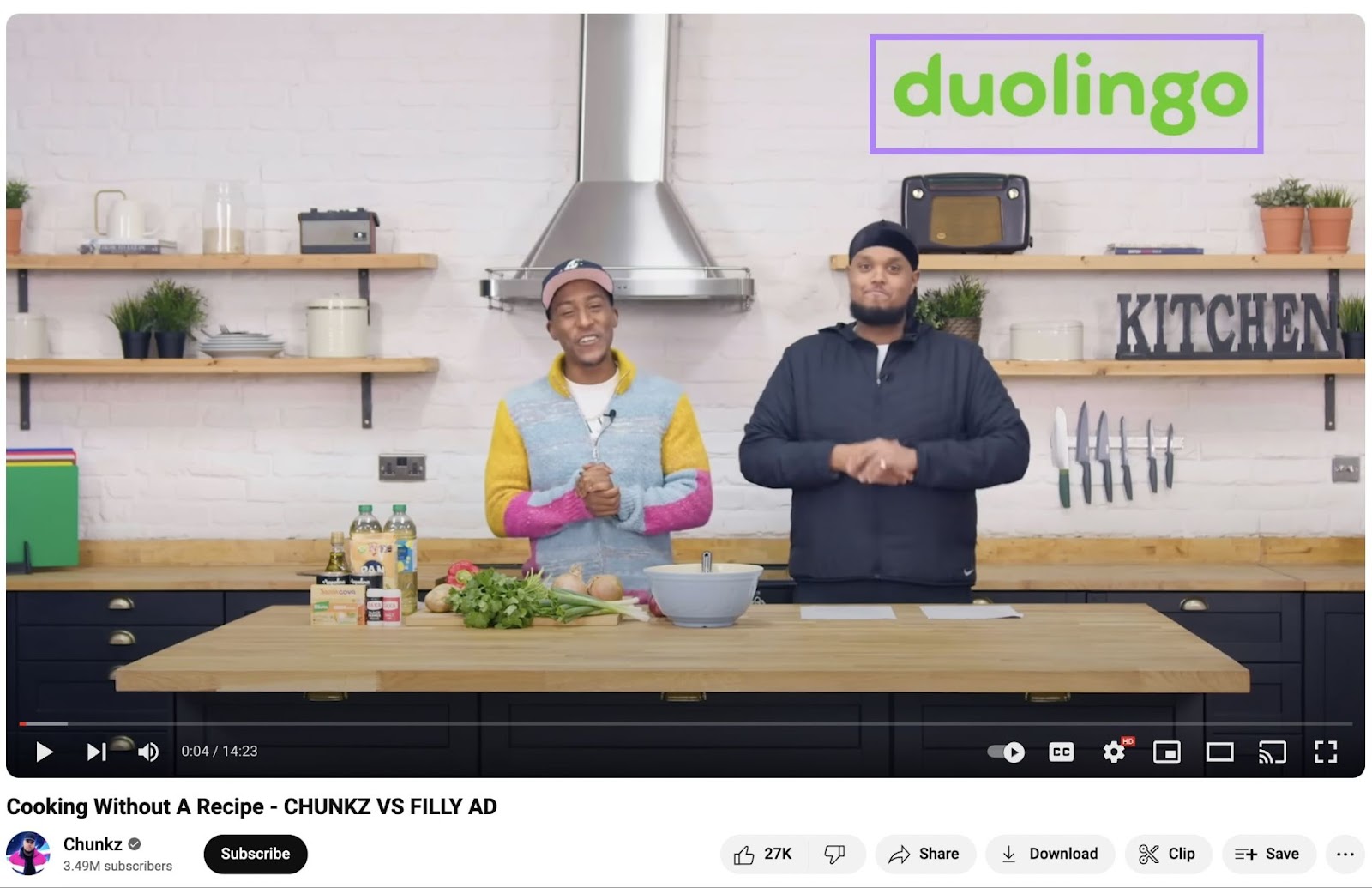
Step 4: Create (or Help Create) Content
Now, explore your partners’ profiles (or websites) and brainstorm some content ideas with them.
If you’re creating a sponsored blog post, use the Topic Research tool to easily find ideas (this can also work for other formats).
Just enter a topic and click “Get content ideas.”
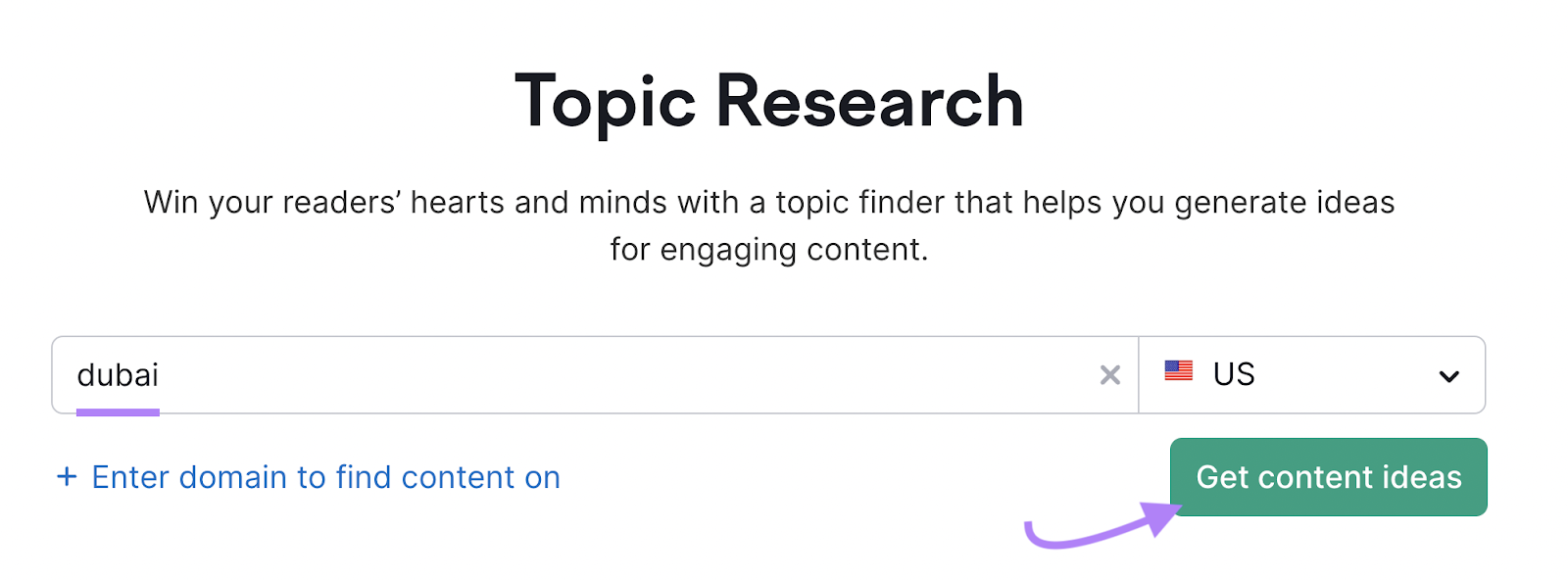
You’ll see a list of content topics grouped into cards. To explore a specific topic, click on “Show more” for the card you’re interested in.
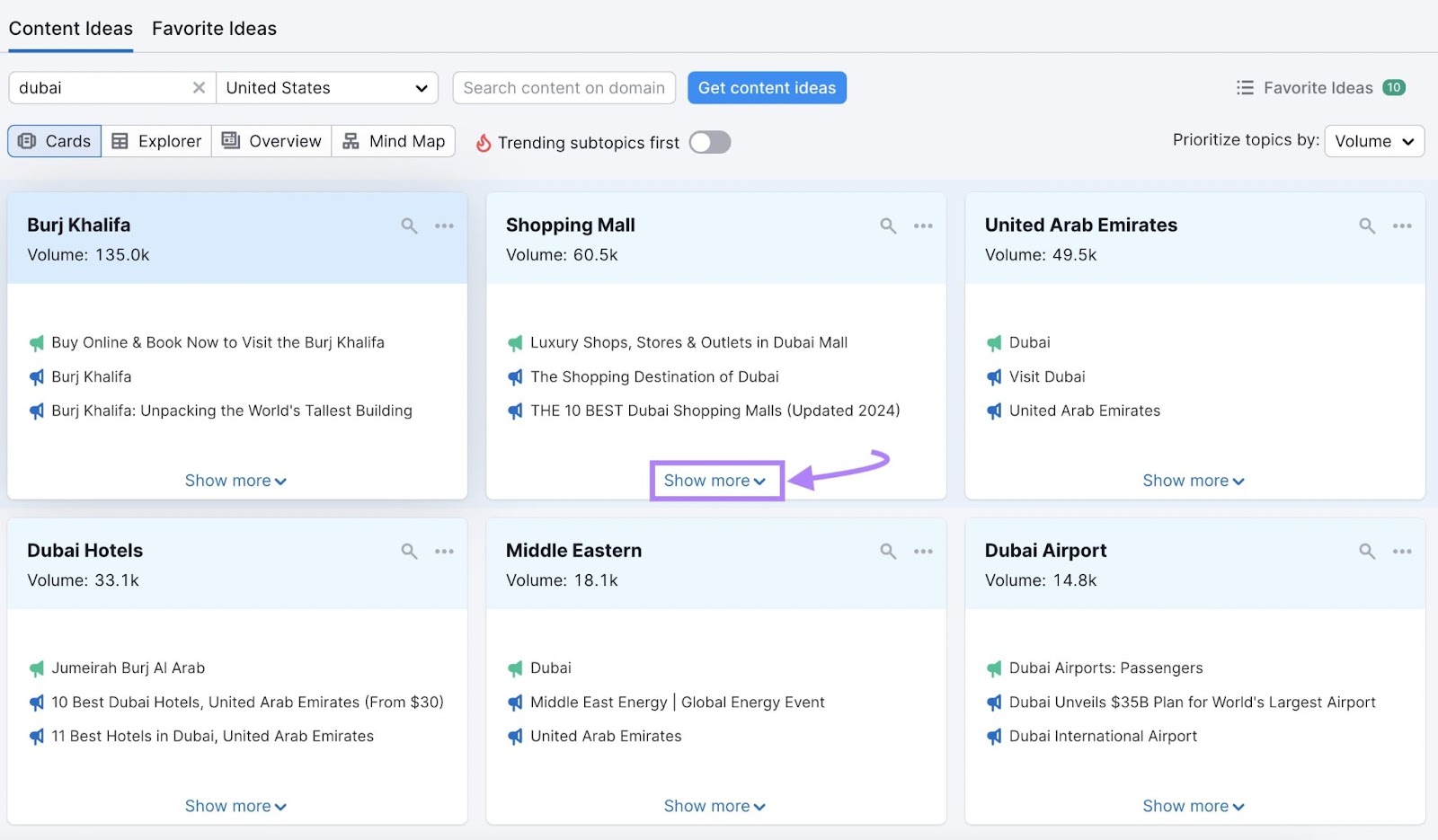
This shows a list of headlines and questions users often type into search engines. Along with related searches.
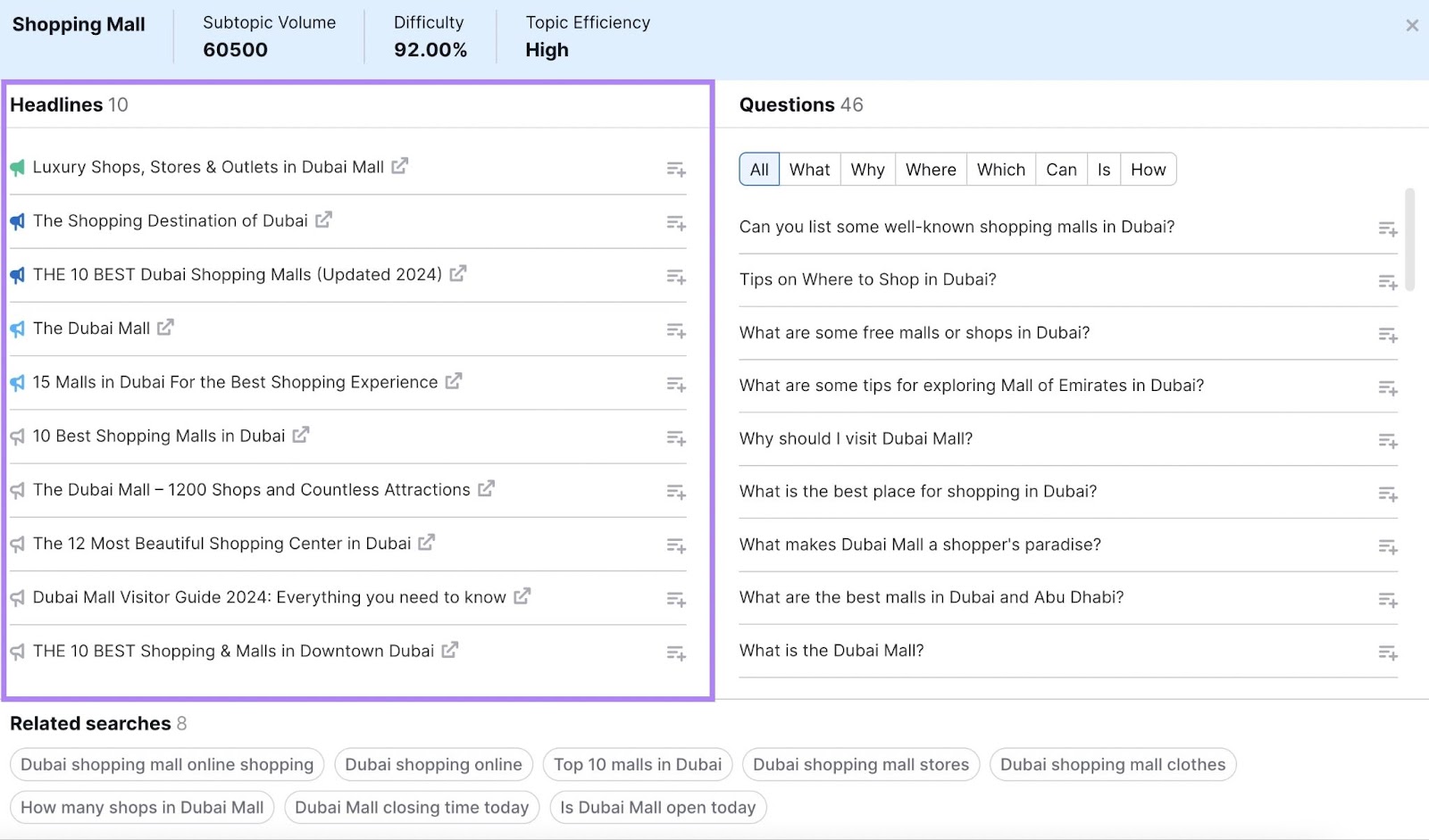
At the top of each card, you can see key metrics for the subtopic. To help you figure out which topics to create content on.
For example, volume indicates the number of monthly searches for that subtopic. While difficulty indicates how hard it may be to get your content to rank well in organic search results.
Ideally, you want to target topics with high volume and low difficulty. These make for a high “Topic Efficiency.”
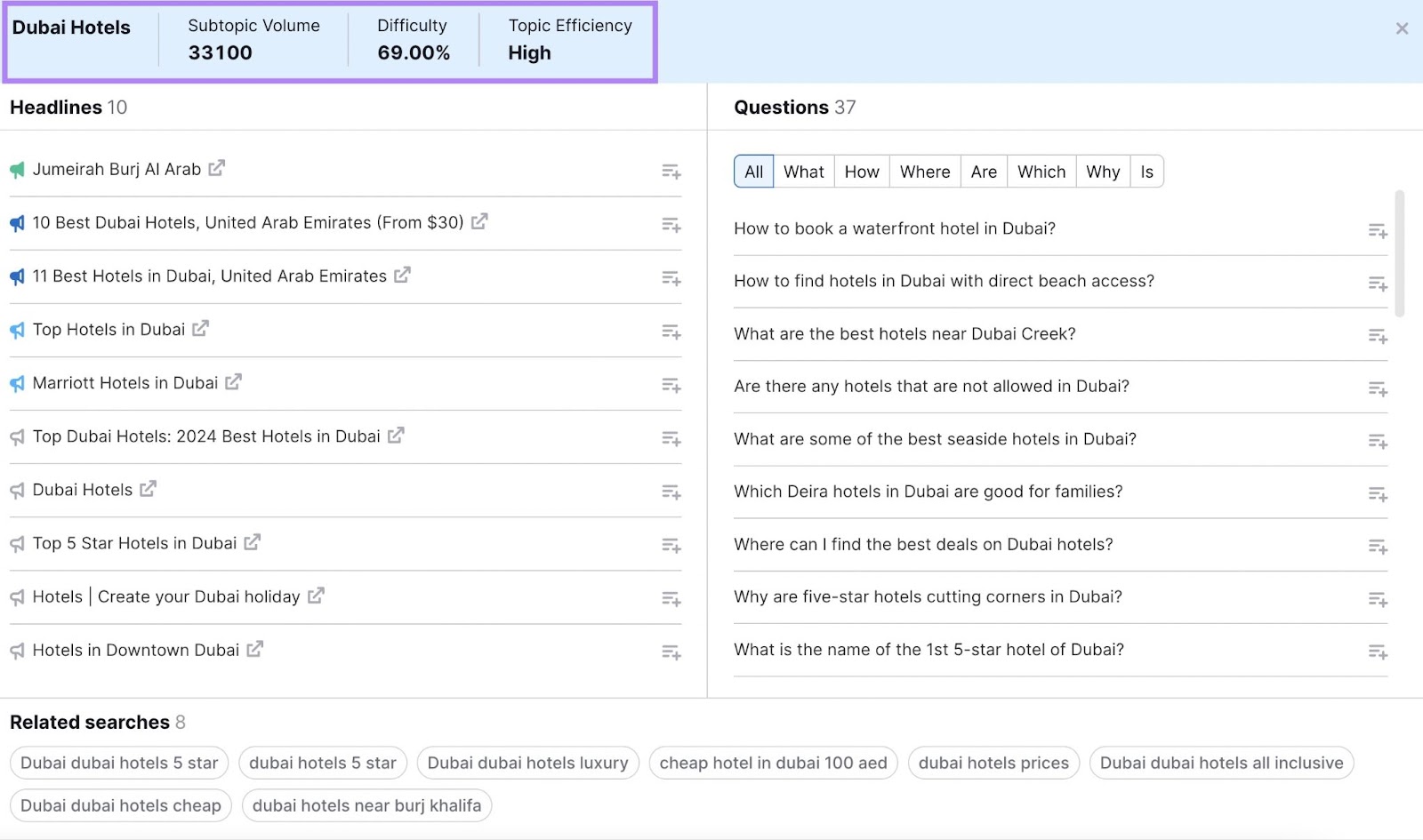
You can then choose to create the content on your own, co-create with your partners, or let them take care of the entire process.
Step 5: Measure Your Sponsored Content’s Performance
Measuring your sponsored content's performance can help you learn which partnerships and content formats perform well. So you can make data-driven decisions for future collaborations.
Here’s a helpful breakdown of metrics to track, depending on your goals:
- Brand awareness and authority: Track referral traffic, views, and social media engagement metrics
- Leads: Keep an eye on the number of newsletter/free trial subscriptions, content downloads, or sign-ups to whatever you’re promoting
- Sales: Track the number of sales and the revenue coming from each specific partner
Feel free to adjust this list and choose the metrics that best fit your campaign and goals.
Achieve Your Goals with Sponsored Content
Sponsored content can help you expand your reach, promote your products to a new audience, and increase revenue.
Semrush can support you during the entire process—like researching your audience with One2Target or finding content ideas with Topic Research.
Sign up for a free trial to streamline your sponsored content production.
